Integrated analysis reveals FLI1 regulates the tumor immune microenvironment via its cell-type-specific expression and transcriptional regulation of distinct target genes of immune cells in breast cancer
- PMID: 38448802
- PMCID: PMC10916124
- DOI: 10.1186/s12864-024-10174-9
Integrated analysis reveals FLI1 regulates the tumor immune microenvironment via its cell-type-specific expression and transcriptional regulation of distinct target genes of immune cells in breast cancer
Abstract
Background: Immunotherapy is a practical therapeutic approach in breast cancer (BRCA), and the role of FLI1 in immune regulation has gradually been unveiled. However, the specific role of FLI1 in BRCA was conflicted; thus, additional convincing evidence is needed.
Methods: We explored the upstream regulation of FLI1 expression via summary data-based Mendelian randomization (SMR) analysis and ncRNA network construction centering on FLI1 using BRCA genome-wide association study (GWAS) summary data with expression quantitative trait loci (eQTLs) and DNA methylation quantitative trait loci (mQTLs) from the blood and a series of in silico analyses, respectively. We illuminated the downstream function of FLI1 in immune regulation by integrating a series of analyses of single-cell RNA sequence data (scRNA-seq).
Results: We verified a causal pathway from FLI1 methylation to FLI1 gene expression to BRCA onset and demonstrated that FLI1 was downregulated in BRCA. FLI1, a transcription factor, served as myeloid and T cells' communication regulator by targeting immune-related ligands and receptor transcription in BRCA tissues. We constructed a ceRNA network centering on FLI1 that consisted of three LncRNAs (CKMT2-AS1, PSMA3-AS1, and DIO3OS) and a miRNA (hsa-miR-324-5p), and the expression of FLI1 was positively related to a series of immune-related markers, including immune cell infiltration, biomarkers of immune cells, and immune checkpoints.
Conclusion: Low-methylation-induced or ncRNA-mediated downregulation of FLI1 is associated with poor prognosis, and FLI1 might regulate the tumor immune microenvironment via a cell-type-specific target genes manner in BRCA.
Keywords: Breast cancer; Cell communication; FLI1; Immune cells; Transcription factor; scRNA-seq.
© 2024. The Author(s).
Conflict of interest statement
The authors declare no competing interests.
Figures

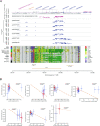
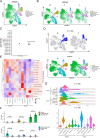
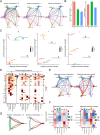
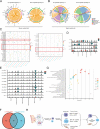
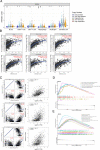
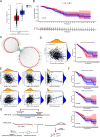
Similar articles
-
Uncovering immune cell-associated genes in breast cancer: based on summary data-based Mendelian randomized analysis and colocalization study.Breast Cancer Res. 2024 Nov 29;26(1):172. doi: 10.1186/s13058-024-01928-0. Breast Cancer Res. 2024. PMID: 39614330 Free PMC article.
-
Comprehensive analysis of a cuproptosis-related ceRNA network implicates a potential endocrine therapy resistance mechanism in ER-positive breast cancer.BMC Med Genomics. 2023 May 5;16(1):96. doi: 10.1186/s12920-023-01511-0. BMC Med Genomics. 2023. PMID: 37143115 Free PMC article.
-
Identification of Five Immune-Related lncRNAs Predicting Survival and Tumor Microenvironment Characteristics in Breast Cancer.Comput Math Methods Med. 2021 Feb 27;2021:6676692. doi: 10.1155/2021/6676692. eCollection 2021. Comput Math Methods Med. 2021. PMID: 33727952 Free PMC article.
-
Integrated pancancer analysis reveals the oncogene characteristics and prognostic value of DIP2B in breast cancer.BMC Cancer. 2023 Mar 31;23(1):296. doi: 10.1186/s12885-023-10751-3. BMC Cancer. 2023. PMID: 37004015 Free PMC article.
-
Genetic and Epigenetic Regulation of the Innate Immune Response to Gout.Immunol Invest. 2023 Apr;52(3):364-397. doi: 10.1080/08820139.2023.2168554. Epub 2023 Feb 6. Immunol Invest. 2023. PMID: 36745138 Review.
Cited by
-
Revisiting the Role of Long Non-coding RNA PSMA3-AS1 in Human Cancers: Current Evidence and Future Directions.Curr Pharm Des. 2025;31(21):1683-1695. doi: 10.2174/0113816128350406241223053744. Curr Pharm Des. 2025. PMID: 39901687 Review.
-
A Systematic Review of Immune Cell Roles in Breast Cancer Immunotherapy.Cancer Rep (Hoboken). 2025 May;8(5):e70217. doi: 10.1002/cnr2.70217. Cancer Rep (Hoboken). 2025. PMID: 40356222 Free PMC article. Review.
References
-
- Watson DK, Smyth FE, Thompson DM, Cheng JQ, Testa JR, Papas TS, et al. The ERGB/Fli-1 gene: isolation and characterization of a new member of the family of human ETS transcription factors. Cell Growth Differ Mol Biol J Am Assoc Cancer Res. 1992;3:705–713. - PubMed
MeSH terms
Substances
Grants and funding
LinkOut - more resources
Full Text Sources
Medical

